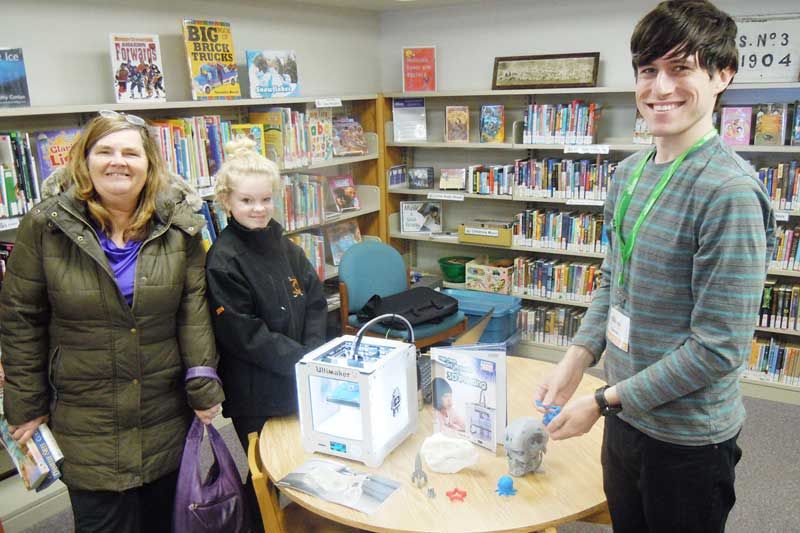Julie Druker | Jan 13, 2016
Many who have heard of the mind boggling capabilities of 3D printers had a chance to better understand the technology thanks to a public service offered by the Kingston Frontenac Public Library. Derek Fenlon, a tech tutor with the KFPL's Central branch in Kingston, was in Sharbot Lake on January 9 sharing the wonders of the Ultimaker 2GO printer with patrons. “I want to show people the potential of 3D printing services that we offer with the hopes that they will utilize this service that is offered to all of our patrons.”
Patrons of the KFPL are being invited to find 3D designs for models online or, alternatively, they can use a number of free online design tools like Tinkercad to design their own 3D objects. These can in turn be emailed to the library’s main branch where tech staff will print the objects for a minimal materials fee and make them available for pick up at the patron’s own branch.
Fenlon said that patrons can also meet with techs at the library's main branch, who will assist them in designing their own objects for printing.
When I visited the Sharbot Lake library branch, Fenlon was explaining to visitors that the printer works by feeding a thin line of plastic filament through an extruder, which heats up the plastic to a temperature of 200 degrees Celsius. Once the plastic has reached the proper temperature, the nozzle at the end of the extruder then moves rapidly and precisely back and forth, and left and right, building up tiny layers of the object. A small silver knight measuring about 2 inches in height, which was in the process of being printed, took the printer about two hours to print. Fenlon explained that the time required for printing depends not only on the size of the object but its density as well. For example, a seven-inch and considerably more dense skull of a T-REX that was on display took 12 hours to print.
Fenlon had brought other printed objects to show to patrons, included an intricate interlinking bracelet, a Terminator head, a rocket ship and a cookie cutter. He also had on display a reference book titled “High Tech DIY Projects for 3D Printing”, which introduces children and adults to the basics of 3D printing and shows them how they can create their own objects.
The technology has been around since the 1980s, and Fenlon said that over the years the printers have become less expensive and more streamlined, and eventually will likely be more affordable to average people. Fenlon himself designed and printed out a miniature replica of the iconic yellow submarine from the Wes Anderson film “The Life Aquatic”. Regarding practical applications of the technology, he said he helped one patron design two replacement knobs for his barbeque and another patron, an engineering student at Queen’s University, used the printer to print out a prototype for a surf board fin.
Fenlon said that 3D printing extends well beyond hobbyists and DIYers and spoke of edible food items and useable objects in wax and metal that are being made. Scientists are currently exploring the possibility of printing human organs using live cells. To date the technology has also been used to print skin grafts and to make prosthetics for amputees. Fenlon said that the technology is also currently being used by business people who use the hobby printers to make various saleable plastic objects and he also knows of full body scanners used in Walmarts in the US by customers who use the scans as the basis for designs.
The technology also lends itself to the need to create objects in remote locations, like in outer space or in the military, Fenlon said. However, regarding the issue of printing guns, Fenlon said that tech staff will refuse to print any dangerous or inappropriate objects.
Fenlon said that while many people have heard about 3D printing, that it is not until they see the printer and how it works that they begin to understand its potential. That proved true when one visitor to the Sharbot Lake branch, Bryan Biondi of Mississippi Station, wondered if Fenlon could create a cookie cutter in the shape of his beloved pet shepherds. Librarian Sara Carpenter quickly found silhouettes of the specific dog breed online, which Fenlon said could be used as the basis to create a design for such an item. “I have a lot of time on my hands”, Biondi said, “and I love to bake and I thought, wouldn't it be great to bake cookies in the shape of my dogs.”
For those who missed the presentation at Sharbot Lake, future presentations will take place at the Storrington branch on Thursday, January 21 from 6 - 8pm; the Hartington branch on Saturday, February 13 from 1 - 3pm, and in Sydenham on Saturday, February 27 from 11am –1pm. For more information about this service visit the KFPL's website at www.kfpl.ca or call 613-549-8888.
More Stories
- The Sun Shines On The Parham Fair
- Creating Your Own Weather, Forever and Ever
- Silver Lake Pow Wow Set For A Big Year
- South Frontenac Receives Substantial Provincial Grant for their Verona Housing Project
- South Frontenac Council Report - August 12
- Dumping To Be Curtailed At Loughborough Waste Site
- Central Frontenac Inching Towards Increasing Severance Opportunities
- Addington Highlands Council Report - August 12
- Addington Highlands Council Report - August 5
- Addington Highlands Council Report - August 12

